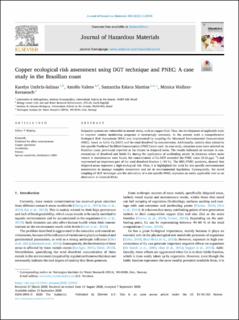| dc.contributor.author | Umbría-Salinas, Karelys | |
| dc.contributor.author | Valero, Astolfo | |
| dc.contributor.author | Martins, Samantha Eslava | |
| dc.contributor.author | Wallner-Kersanach, Mônica | |
| dc.date.accessioned | 2021-07-16T08:47:05Z | |
| dc.date.available | 2021-07-16T08:47:05Z | |
| dc.date.created | 2020-10-08T11:55:27Z | |
| dc.date.issued | 2021 | |
| dc.identifier.citation | Journal of Hazardous Materials. 2021, 403, 123918. | en_US |
| dc.identifier.issn | 0304-3894 | |
| dc.identifier.uri | https://hdl.handle.net/11250/2764615 | |
| dc.description.abstract | Estuarine systems are vulnerable to metals stress, such as copper (Cu). Thus, the development of applicable tools to improve routine monitoring programs is increasingly necessary. In the present work a comprehensive Ecological Risk Assessment (ERA) was implemented by coupling the Measured Environmental Concentration (MEC), based on labile Cu (DGT) and the total dissolved Cu concentration. Additionally, toxicity data related to site-specific Predicted No Effect Concentration (PNEC) were used. As case study, estuarine areas were selected on Brazilian coast, previously reported as Cu release in shipyard areas. The results indicated an increase in concentrations of dissolved and labile Cu during the application of antifouling paints. In locations where more vessels in maintenance were found, the concentration of Cu-DGT exceeded the PNEC value (0.16 μg.L−1) and represented an important part of the total dissolved fraction (>93 %). The MEC/PNEC quotients, showed that shipyard areas represent a high ecological risk. Thus, it is highlighted the need for site-specific environmental assessments to manage complex ecosystems and set in environmental legislation. Consequently, the novel coupling of DGT technique and the derivation of a site-specific PNEC represent an easily applicable tool as an alternative to classical ERAs. | en_US |
| dc.language.iso | eng | en_US |
| dc.publisher | Elsevier | en_US |
| dc.rights | Attribution-NonCommercial-NoDerivatives 4.0 Internasjonal | * |
| dc.rights.uri | http://creativecommons.org/licenses/by-nc-nd/4.0/deed.no | * |
| dc.title | Copper ecological risk assessment using DGT technique and PNEC: A case study in the Brazilian coast | en_US |
| dc.type | Peer reviewed | en_US |
| dc.type | Journal article | en_US |
| dc.description.version | publishedVersion | en_US |
| dc.rights.holder | 0304-3894/© | en_US |
| dc.source.pagenumber | 10 | en_US |
| dc.source.volume | 403 | en_US |
| dc.source.journal | Journal of Hazardous Materials | en_US |
| dc.identifier.doi | 10.1016/j.jhazmat.2020.123918 | |
| dc.identifier.cristin | 1838176 | |
| dc.source.articlenumber | 123918 | en_US |
| cristin.ispublished | true | |
| cristin.fulltext | original | |
| cristin.qualitycode | 2 | |

